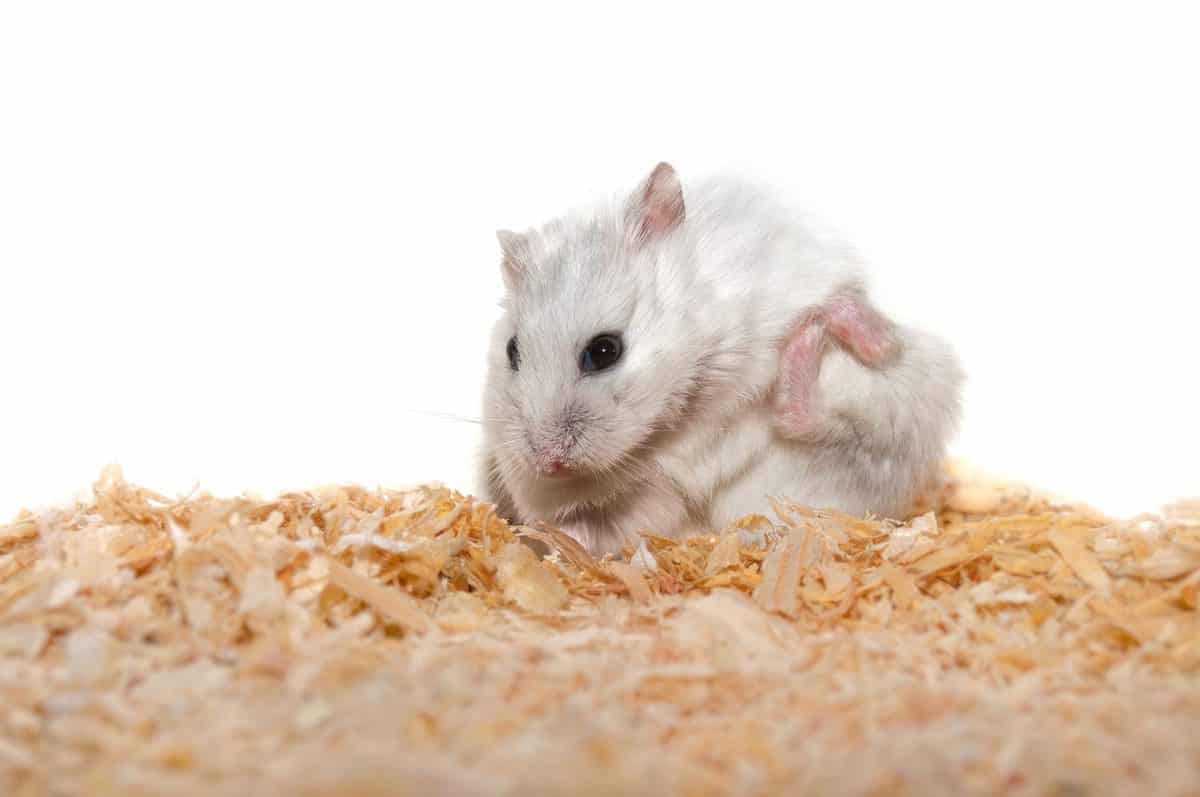Hamsters are little balls of fur that can make great pets and bring a smile to any face. But how many toes does your adorable little fluffball have? We've done the research and have your answer.
All hamsters, including Syrian, Russian Dwarf, Winter White, Roboroviskii, and Chinese have four toes on their front paws and five toes on their rear paws. That makes for a total of eighteen toes.
Hamsters sure are interesting little creatures. If you have more questions about their toes, how to keep them clean, and what to do in the case of chewing their paws, then you're in the right place. We'll discuss these topics and more in this post. So make sure to keep reading!

Do Hamsters Have Hands Or Paws?
Hamsters have paws. They are very dexterous, but they are paws. Unlike human hands, hamster paws have no opposable digit. A hamster can wrap their entire paw around something, but not grip it in the way we do.
You will often see hamsters holding food in their front paws while eating, like this:
This may lead some people to think of their front paws as hands. But you will notice when they grasp items like this, it will always be between both of their front paws. This is because they lack the ability to grip things with a single paw.
Hamsters walk around on all fours, and they have pads on the bottom of their paws. These pads act as cushions when they step.
Why Do Hamsters Sometime Chew On Their Feet?

A few things that can cause a hamster to chew on their feet include:
- Infection
- Parasites
- Itching
- Injury
- Irritation
Infection
If your hamster has an infected foot, they may gnaw at it. This infection can start from a minor scratch or an injury, which then becomes infected. It can also be from bumblefoot, which is an inflammation on the footpad that allows bacteria to enter into the foot.
Some of the symptoms that your hamster may have an infection are:
- Red or swollen foot
- Foot seems sensitive
- They limp
- They do not move around the cage as normal
If your hamster has an infected foot, you need to take them to the vet. Until you are able to do that, move the hamster to a fresh, soft, dry bedding. If the infection is serious enough, the vet may have to amputate the foot. Hamsters often live happy lives on three legs, so don't worry if that's the case.
Parasites
Another possible reason your hamster could be biting its feet is that it has picked up some mites, fleas, or lice, which are causing them to itch. You should clean your hamster with warm water, then comb through its fur to look for signs of infestation.
Clean the hamster's cage and everything in it at least once a week. If washing the cage regularly and cleaning the hamster takes care of the matter, your hamster may have been suffering from an allergy or irritant instead of or on top of having parasites.
Itching

If your hamster is constantly chewing at its feet, it could be because they are itching. This can be from parasites like we mentioned above. An allergic reaction to the bedding or something else in its enclosure can also cause this.
If you've changed the type or brand of bedding or added any new items to the cage recently, try removing this for a few days to see if this improves things. Make sure to clean everything carefully with a warm cloth, but avoid using any harsh chemicals that your hamster may have a reaction to. If your hamster is still chewing on its feet, you may need to call your veterinarian.
Injury
If your hamster has an injury on its foot or leg, it may begin chewing on it. This can be their attempt to stop the pain. Examine the area carefully and see if you can see any evidence of an injury. Be careful to wrap the hamster in something soft and hold them firmly, since a hamster in pain may bite.
If you see signs of an injury and it is minor, you may be able to clean the area with warm water or saline, then apply a disinfectant like betadine. Follow that with a thin layer of antibiotic ointment, then leave your hamster alone to recover in its cage for a few days. You may want to move its food and water nearer to its sleeping area so it won't have to move about as much.
If the wound is more serious, then take your hamster to the vet.
Some signs of injuries in hamsters include:
- Lack of appetite
- Bleeding
- Sleeping a lot
- Cries of pain
- Aggression
- Limping
Do not handle an injured hamster any more than necessary. Other than handling to examine them, treat injuries, or take them to the vet, you need to leave them alone for a few days to heal.
Irritation

If your hamster suddenly starts chewing on its foot shortly after you've switched to new bedding or added a new toy to its enclosure, it could be a sign that they have an allergy or irritation caused by the new item. Remove the new item or switch back to the old bedding, then wash the cage well.
Household cleaners used while cleaning the cage, or even near it, can cause irritation. It is best to use only warm water and mild detergent, if any detergent at all, to clean the cage.
If you are unable to pinpoint any changes that may have caused irritation to your hamster's foot, then you may need to take it to the vet. It's possible it could be something else, such as a bacterial infection, and not an allergy.
How Do You Trim Hamster Nails?

Hamster nails can grow too long, causing them to curl under or sideways. If this happens, you need to trim their nails. If your hamster is very comfortable and calm with you, you may be able to do this yourself. In some cases, you may need to take them to the vet for this because they won't sit still for it.
If you are going to trim the nails yourself, you'll need to place the hamster on a safe surface, like a large table or bed. Your other option, if your hamster is comfortable with it, is to hold the hamster on its back in one hand so you can trim with the other hand. Many hamsters will not be comfortable with this.
Look carefully at the nail, with plenty of lighting. You are only going to cut the very end, somewhat translucent part. Make sure not to cut into the quick, which is like the fleshy area under your fingernail. On a hamster, this may appear as a cloudy area near the back edge of the nail. Do not go near that area.
You can use very small nail clippers, such as those used for babies or specifically for small animals.
Click here to see this product on Amazon.
If you can successfully trim one nail and your hamster is still relatively calm, you can continue. If they are becoming agitated or nervous then put them back in their cage for a while and try again later. Sometimes you may need to wait a day or so before continuing.
Things may go smoother if you give your hamster a treat after each trimming. They can begin associating the trimming with getting a treat, which could make it easier to handle them next time. If not, at least it will help them feel a little better about the experience afterward.
This is not an easy process, so many times you are better off taking your little hamster to the vet to have their nails trimmed.
One thing you can do if you notice the nails getting a little long is to place things around the cage that will help wear away the nails over time. This can help prevent the need for future trimming. Find some stones that are a couple of inches across, clean them, and place them around the cage. Stepping on the stones regularly will slowly wear away at the nails, keeping them from growing too long.
Sometimes sand baths can help with nails. Hamsters will dig at the sand, and it can wear away their nails. This may be one way to limit the need for nail trimming.
How Do You Know If Your Hamster Has Bumblefoot?
Bumblefoot is an inflammation of the foot. If left untreated it can become severe. Some of the signs of bumblefoot are:
- Lack of appetite
- Lethargy
- Red and swollen feet
- Won't move around the cage as usual
- Sensitive feet
- Ulcers and scabs on feet
Rough surfaces in a hamster's enclosure can cause bumblefoot. A wire floor, for example, can cause scrapes that become infected. Bedding soaked in urine or feces can also be a cause. In some cases, obesity or overgrown nails can cause bumblefoot.
If you think your hamster has bumblefoot, take it to the veterinarian for treatment.
In Closing
Hamsters have a total of eighteen toes. They have four on each of their front paws and five on each of the back paws. As discussed above, your hamster's tiny paws can suffer from injuries or illness. If they have a serious injury or illness, you will need to take your furry friend to the vet for treatment.
Check out these other helpful hamster guides before you go:



![A cute little hamster lying inside his pink cage, Can You Take A Hamster On A Plane? [And How To]](https://hamsters101.com/wp-content/uploads/2021/08/A-cute-little-hamster-lying-inside-his-pink-cage-300x200.jpg)
